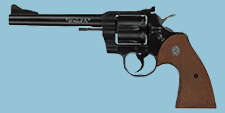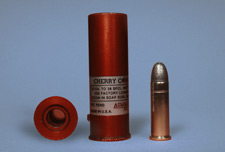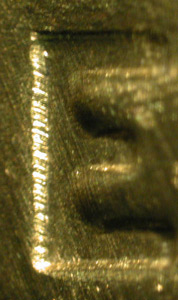Home | Glossary | Resources | Help | Contact Us | Course Map
Archival Notice
This is an archive page that is no longer being updated. It may contain outdated information and links may no longer function as originally intended.
Examination Challenges
The three types of fired cartridge case and shotshell case comparisons can be complicated by a number of practical challenges.
These challenges may be encountered in examination of the following:
- Cartridges
- Inappropriate interchangeability
- Cartridge cases
- Reloading toolmarks
- Manufacture/assembly factors
- Firearms
- Use of adapters
- Substitution of parts
- Modifications
- Manufacturer-related factors
Cartridges
Cartridge Interchangeability
Some firearms are purposely designed to use more than a single cartridge type. An example is the .357 Magnum caliber revolver, which is also appropriate to use with .38 Special caliber ammunition. This type of interchangeability is appropriate and safe and should be expected by firearms examiners. However, there are many inappropriate and unsafe situations in which the wrong type of cartridge may fit into the chamber of a firearm and be fired. This can be both unsafe for the shooter and deceptive for a firearm examiner who is unaware of the possibility and may disregard the evidentiary potential of the fired cartridge case. In some cases revolver cartridges may be fired in pistols, as well as the reverse. Often, the physical effects may include swollen or split cartridge cases. Another indicator may be a blackened or sooty area along the split from the escaping gases. All of these possibilities should be considered so that evidence is not eliminated from consideration.
| Caution: |
|
In some cases, cartridge interchangeability is safe and possible by design; in other cases, this is unsafe and inappropriate. |
Cartridge Cases
Reloaded Cartridge Cases
Marks on reloaded cartridges may contain unique and reproducible microscopic characteristics, specifically, striated and impressed toolmarks. However, they are identifiable with the reloading tools that made the marks, not with the firearm that fired the cartridge case. These marks may also be inconsistent as a result of the lack of quality control associated with reloaded ammunition.
Reloading toolmarks may result from the following:
- Cartridge case holding tools: These tools physically grip cartridge cases by the base while in a reloading press.
- Resizing tools: These tools are used to compress fired cases which were slightly expanded during obturation back to their precise original dimensions.
- Crimping tools: These tools are used to slightly crimp the mouth of cartridge cases to bullets in some loads.
Ammunition Manufacture or Assembly Factors
- Manufacturing marks on primers: Repetitive marks may be noted on the surface of fired primers. These are actually due to the processes for manufacturing primers and have nothing to do with the discharge of a firearm. These marks will almost never remain in the same relationship to the class characteristics left on the fired cartridge. Manufacturing marks can also be distinguished by the fact that they often extend into a firing pin impression.
- Bunter marks: These are marks made by the die which produces the headstamp on rimfire cartridge cases or the headstamp and primer pocket on centerfire cartridge cases. These marks have nothing to do with marks produced by a firearm, but they do allow an examiner to state that two headstamps were produced by the same die.
Only research in a given case will determine how much or how little significance attaches to such an identification. This is normally done on an exceptional basis when all other avenues have been exhausted as far as establishing an association between two cartridge cases or shotshell cases.
This is not the method of choice for relating cartridge cases and shotshell cases to a single source.
Additional Online Courses
- What Every First Responding Officer Should Know About DNA Evidence
- Collecting DNA Evidence at Property Crime Scenes
- DNA – A Prosecutor’s Practice Notebook
- Crime Scene and DNA Basics
- Laboratory Safety Programs
- DNA Amplification
- Population Genetics and Statistics
- Non-STR DNA Markers: SNPs, Y-STRs, LCN and mtDNA
- Firearms Examiner Training
- Forensic DNA Education for Law Enforcement Decisionmakers
- What Every Investigator and Evidence Technician Should Know About DNA Evidence
- Principles of Forensic DNA for Officers of the Court
- Law 101: Legal Guide for the Forensic Expert
- Laboratory Orientation and Testing of Body Fluids and Tissues
- DNA Extraction and Quantitation
- STR Data Analysis and Interpretation
- Communication Skills, Report Writing, and Courtroom Testimony
- Español for Law Enforcement
- Amplified DNA Product Separation for Forensic Analysts





